May 2017
Kia Ora Aotearoa
Hello, Welcome to New Zealand
After enjoying a wonderful five weeks on South Island, we took the ferry from Picton to Wellington, and started a quick drive up to Auckland to change vehicles (don’t ask). We made one brief stop right after we got out of Wellington, to look back out over the water toward South Island, sparkling in the sun, then turned our faces north.
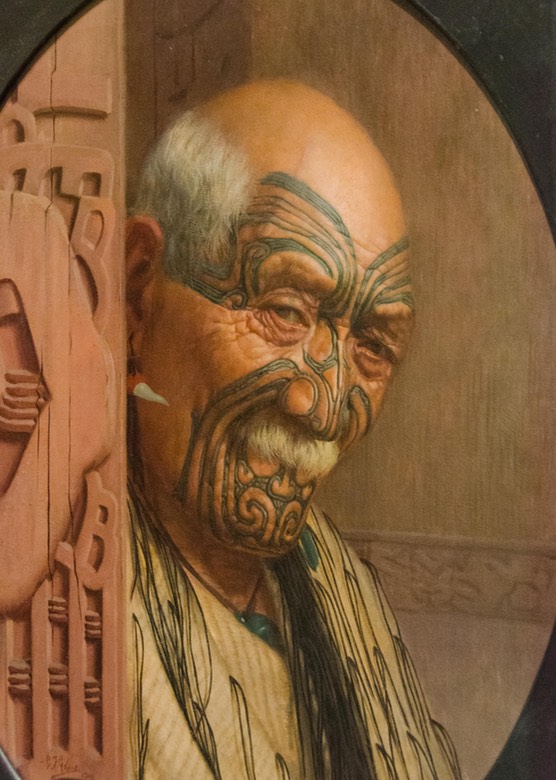
We’d been told that the North and South Island countryside, people, and culture had distinct differences. It’s really true. For us, the most apparent change was in the makeup of the population, and how it was reflected in our cultural experiences. The Maori presence is stronger and more dominant here in North Island. More towns have Maori names, and large sections of the island are maintained by them. The physical aspects of their culture are a regular sight: meeting house areas (marae), churches decorated with a Maori influence, and local museums featuring collections of awesome artifacts and discussions of the local history and important personages, often with great collections of old photographs. So we bid you welcome — Kia ora Aotearoa — join us as we explore North Island.
It took us almost a day and a half to get to the drop-off spot — just as with South Island, North Island is far bigger than it looks on the map. We drove through areas we knew we wanted to see, but they would have to wait until later, as we were now on a schedule (damn!) and couldn’t take the time to explore. We did take note, however, that as we drove through the town of Bulls, we were greeted by a sign saying “Bulls — A Town Like No Udder.” It was good to see that corny humor was alive and well in North Island.
Our overall rough plan was to change rigs, see Auckland and the northern part of the island, drive down the western side to Wellington and environs, then back up, zig-zagging back and forth between the central and eastern sides of the island, and end up back in Auckland five weeks later. We would then get rid of the rental and fly to Melbourne. Whew!
When we dropped off our second van (Lurch) in Auckland, we picked up Scow II and then went to visit as-yet-unmet friends. Sandra and Richard and I had been in touch for some time, as they are going to be in the US for several months starting in June and were asking some questions. They invited us to join them at their home outside Auckland, we happily accepted and spent a lovely 4 days there, visiting, trading travel stories, learning more about North Island and being taken around to some really lovely spots. We had lunch along the water at their local harbor; then drove into the city to see the Maritime Museum, with excellent displays on the arrival of Captain Cook in 1769, the voyages of European settlers coming out to find a new life in a new land, and New Zealand’s efforts in the Americas Cup yacht racing series. We spent a lovely day wandering the harbor area downtown and some of the suburbs, and took a special drive up to Cornwall Park to enjoy One Tree Hill and the views of the city from the top. We had a super time and hated to say good-by.
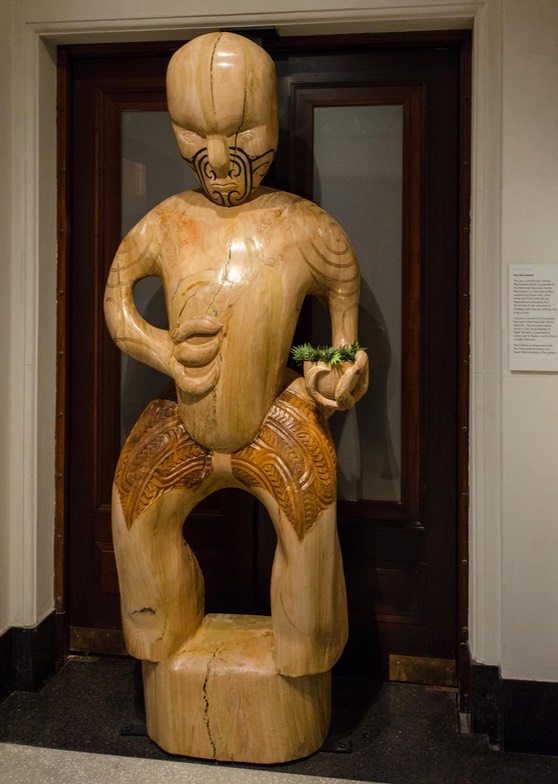
We finally tore ourselves away one morning and started north, with a very pleasurable visit to the Auckland Museum before leaving the city. This is an excellent museum that serves also as a war memorial for the City of Auckland. Displays range from dinosaur skeletons to modern times, but the main emphasis is on Maori culture and history and on New Zealand’s involvement in the wars of the past hundred years. We were especially taken by the wonderful exhibitions of Maori carvings including many boats of varying sizes and types and most especially the ongoing restoration of a beautiful Maori meeting house. The exhibits on Pacific and Asian Art were also terrific and the War Memorial galleries were moving and very well done. Historically as well as in modern times, Maori culture is much more prevalent in North Island than South, and this was one of our first exposures to their extensive art and history.
Our adventures on the rental van front have continued. We have a noise on the Scow II front that is sufficiently annoying to be worthy of comment — a buzzer that goes off roughly every 10 minutes reminding us that the van is long overdue for service. Apollo says it’s fine but we still have to listen to the noise. We’ve named it SB and call it Bleeker; now this is rather obscure, but it pleases us. SB is for Service Bleeper; modified to Bleeker because that’s the name of Juno’s boyfriend in the delightful movie Juno. Hope you’ve seen it.
Drivers in NZ tend to go the speed limit, no more and no less, and usually you aren’t crowded. Not a pushy group — except perhaps in the Auckland immediate area where normal city traffic rules override any national tendencies leaning toward civility. Oh, and the country’s transportation department apparently has an excess of highway cone markers on hand — every little spot that’s being marked off seems to need at least 10 cones where we might consider 2-3 to be quite adequate.
Finally moving further north, we crossed the bridge over Auckland’s harbor area and began our exploration of the area “above” Auckland. It started out almost as busy as the city itself, then after a day or so got a lot quieter. We drove out to Gulf Harbor, where we spent two very wet days enjoying a storm coming through. We were right on the water, it was blustery and very damp; very nice.
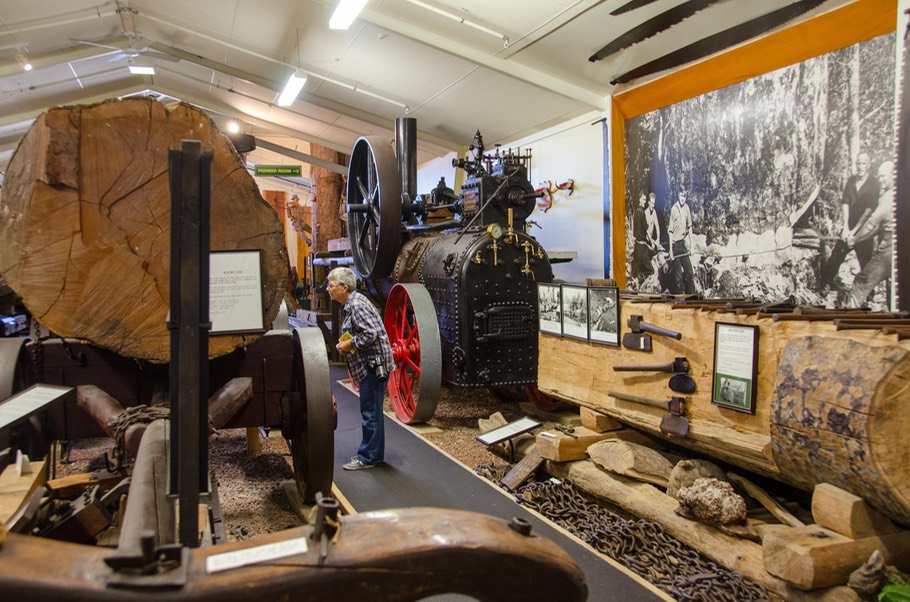
The storm abated and we were off to see rural Northland. We headed to the west coast by way of Matakohe, in order to see the Kauri trees in all their glory. These enormous trees, second only to the California sequoias in size, once covered a large portion of the North Island; not true today. Once European settlers arrived, the forests were systematically harvested — for the beautiful furniture it made, spars for sailing ships, gum from the sap, and more. Fortunately, they are now protected, and the small number of trees still extant is safe. Relatively. There is now a disease called kauri dieback which is threatening the trees, transmitted through the soil and water, so great care is taken when you go visit.
But I get ahead of myself. We started by stopping at the really excellent Kauri Museum, which was a particularly special treat. We spent an entire morning there. There were lots of impressive exhibits to enjoy. A lot of the logging of the trees took place during a time when photography had become available, and a local photographer had done amazing work recording the work as it happened. There are photos everywhere, detailing how felling the trees was done, how the logs were hauled away, really great pictures. There were also examples of sections of logs. Now these are really big logs. Bigger than people, for sure. Another feature of the museum that was new to us was the use of mannequins showing how certain work was done, with the faces of the people made from cast molds of local folks, many of them descendants of the earlier logging community. We really enjoyed ourselves.
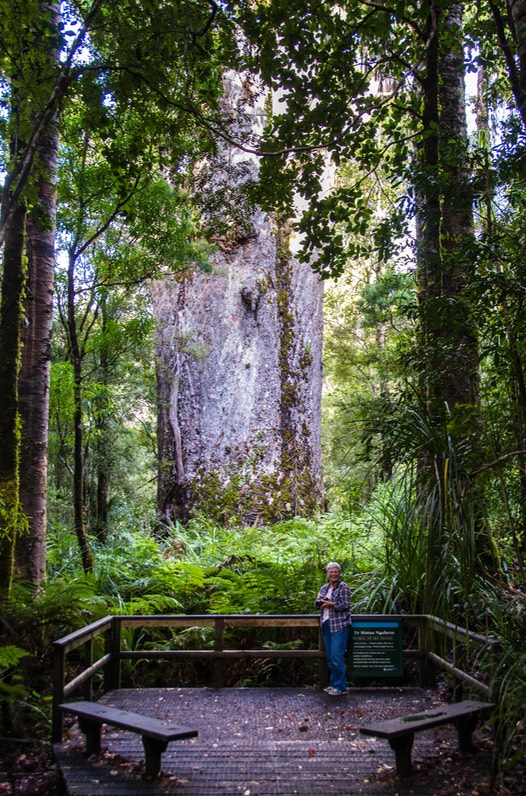
When we finally moved on, we wanted to stop at a kauri forest (Waipoua Forest) not too far away. In that forest are Te Matua Ngahere (the oldest living specimen and largest in diameter), known as “Father of the Forest” and also Tane Mahuta, “Lord of the Forest” which contains the largest volume of wood in one tree. We stopped and talked to the woman running the visitor center at the entrance to the forest; she was fun to talk to, had lots of information, was ready to close for the day, and sent us out to explore. She was fun.
It was great walking in the forest, down paths among the ferns and other low plants. You’d reach one of these enormous guys and have to stop and catch your breath before you could take one in. I saw them both; they are humungous and magnificent. The kauri trees are usually cylindrical, and free of limbs for quite a distance going up — there are epiphytes growing on the lower parts of the trunk. Seeing them is quite an experience. And the ferns were pretty cool, too.
This is definitely Maori country. Many more people, lots of small museums with artifacts and history, more Maori names for towns and streets, meeting houses in or near most communities, all making for a really interesting experience. We really liked being up here. The Maori areas so far seem more rural and less compulsively tidy; the land is being well used and productive, just less ‘Genteel’. We had been cautioned to be a bit careful in certain places, but found no evidence of need. Folks were very friendly and interested but never a sense of threat. We’re glad to be able to report this.
We were seeing wild turkeys everywhere out in the open, and this was true all over the island. Cornstalks are still in the fields, along with some field crops, although maybe they are just fodder for the critters. And yes, lots of cattle, although fewer sheep and no deer yet. Also, up here this far north it’s definitely more tropical, and both the avocados and tangerines are ripe and plentiful in the stores. There is pampas grass everywhere, plus hibiscus, hollyhock, and other tropical plants. And we must not forget the plentiful Norfolk Island pines. Norfolk Island, by the way, is north of here in the South Pacific, not in Virginia as one might choose to assume.
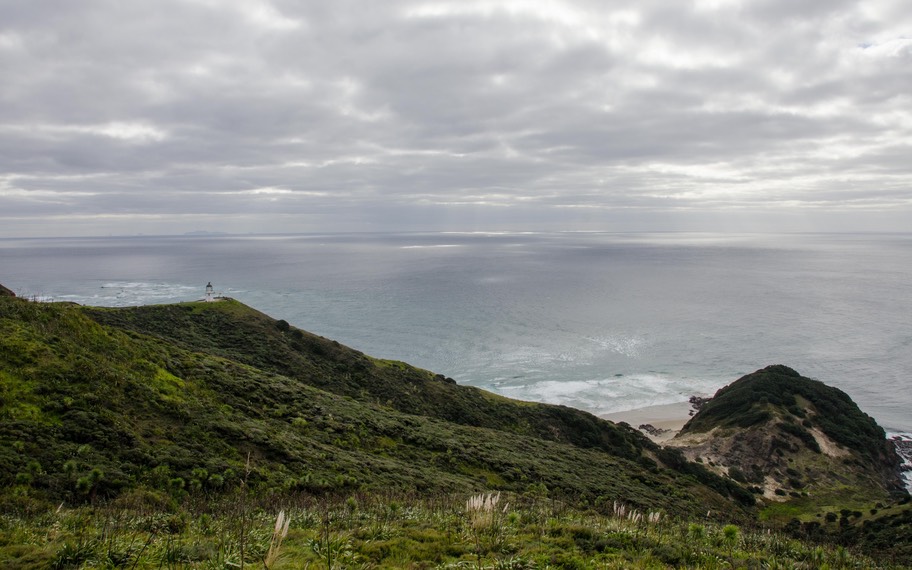
Our big goal in Northland was to get out to Cape Reinga, at S34.42990 the northernmost point on mainland New Zealand. We hiked down to the lighthouse, a very popular photo-op. It was a great spot. This is the point where the Tasman Sea and the Pacific Ocean collide. There was a significant maelstrom at the point of contact and we stood and watched it for some time. It all made for a terrific ‘Land’s End’ experience.
Beginning to slowly move back towards Auckland and points south, we had a lovely stop in Mangonui, a nice old-fashioned harbor, and then dropped on down to Whangarei, where we hung out for a couple of days. There was pleasant parking at the very pretty Town Basin, full of yachts and historic properties and within walking distance to what we wanted — our mail. We arrived ahead of our package, but it showed up only a day later. Very satisfying. We had hard rain some of the time while we were there, but in general we’ve had excellent weather here in New Zealand. It has been pleasantly warm this far north; happy to report malleable butter at all times.
Approaching Auckland again, we came down a more westerly, much quieter road than we’d taken heading north, which took us through rural lowland areas and the nice little delta town of Helensville, which reminded us of the Mississippi Delta and even more the Sacramento delta area east of San Francisco Bay. Memories of home. Oh, and we passed a sign that disappeared pretty quickly but we think it said Gluten-Free Poo. Not sure we should even mention that in a family newsletter, but we guess it’s OK.
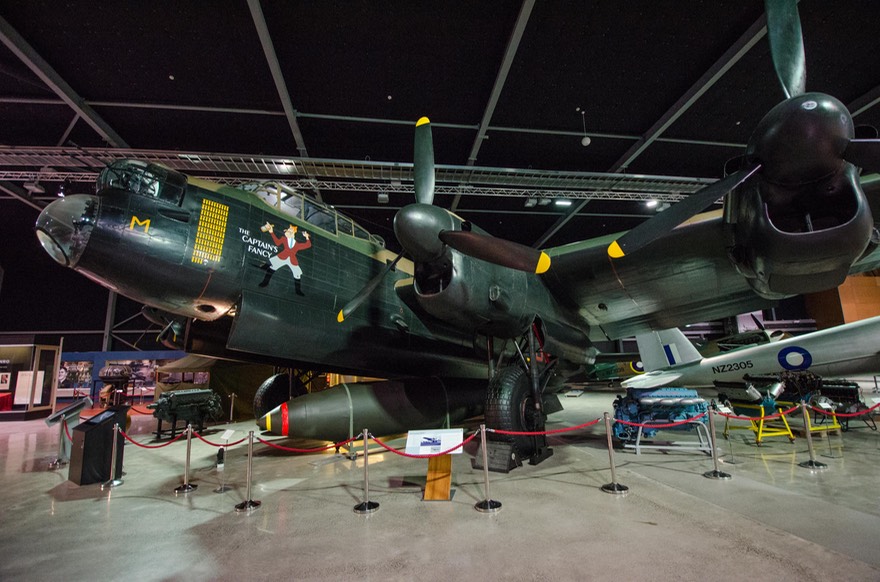
Going back through Auckland, we had one last big stop to make, the MOTAT Aviation Museum. MOTAT is the Museum of Transport and Technology and since we knew we had to return through Auckland after our Northland tour we’d planned to pick it up on the way south. Auckland is a real bottleneck up here in North Island. It sits astride a narrow isthmus with no way around it in a vehicle; so through the city we had to go. This museum is spread out between two sites straddling the city’s Zoo. The only part we cared about was the aviation display so that’s where we went; actually that’s where Rick went while Kathy caught up on chores in the van. The museum features a truly wonderful exhibition on New Zealand’s participation in the Royal Air Force Bomber Command in WWII, and pride of place goes to a rare restored Avro Lancaster bomber and well done video interviews with surviving crew members. Of more than 6,000 New Zealander’s who volunteered for duty in Bomber Command, 1,850 were killed. The materials used and the stories told of the experiences of these men were moving and make a fitting tribute to their sacrifice. There were other interesting aircraft on display, and an exhibit honoring Sir Kieth Park, the New Zealander who led the RAF Fighter Command during the war and especially during the Battle of Britain.
Then we moved past the Auckland bottleneck and on into the more southerly regions of North Island. Or so we thought…
Then That Happened. Getting fuel in the Hamilton area, we realized we’d left our credit card back at our previous fuel stop way north of Auckland, in Whangarei. Damnation. Just having to backtrack wouldn’t have been so bad, but it meant we had to drive through the Auckland traffic again — twice. Bah! But we did it, taking about 4 hours each direction and spending another night at the Town Basin there (not a total loss as I’d spotted a great pizza spot there and we now would have a chance to enjoy it). Especially attentive readers might remember a similar experience we reported ten years ago when we crossed Mexico City three times on one busy Sunday after realizing we’d left something important behind. After that experience, Auckland was child’s play.
Also, in returning south through Auckland we came through at the start of the afternoon commute, and encountered the fascinating Barrier Machine in operation! Boy this thing was cool. We’d been slogging through afternoon traffic with lanes reducing and all that sort of thing when we saw one of those electronic sign thingies warning of problems ahead because of: “Barrier Machine in Operation”. As we wondered just what that was we came upon it and could see for ourselves. The physical divider between the different directions of traffic flow seemed to be like a series of short sections attached together rather than a permanent concrete barrier, and so it was. Along came this fairly massive piece of equipment moving at a pretty rapid pace sucking up the barrier on one side of itself and then leaving it behind on the other side; thus moving the barrier to suit the afternoon commute. Wow! We thought this was pretty cool. You may have already seen such a thing, and it’s probably not unique, but not being city people, thank goodness, it was new to us. As we occasionally remind you, one of the secrets of our continued happiness is that we are indeed easily amused.
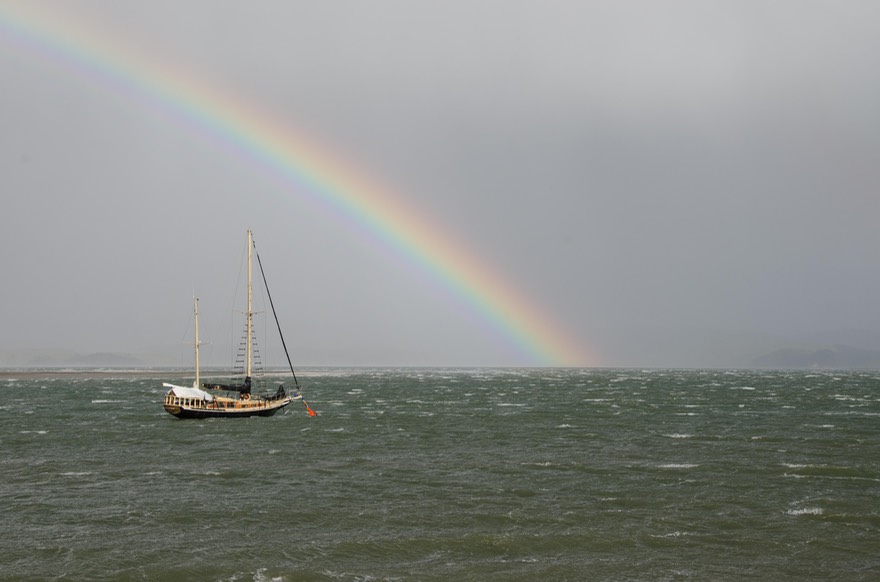
The next morning, in occasional driving rain, we passed the usual Saturday morning activity — youth rugby and soccer games — kids and parents everywhere; always a reassuring sight we think. Picking up the thread of our travels again, we waved at Hamilton in the distance as we passed it moving south. The area was filled with rural pastureland, nice ranch houses, lots of trees still showing fall color. It was quiet and nice after too much time roaring around on the highways. (We heard a rumor that South Island was getting a big snowstorm at this point and were happy to be further north.)
We drove out to the west coast at Kawhia, through heavy gusting winds and tree limbs and branches on the roads. There is a nice little local museum there, with whaling exhibits and a Kauri whaling boat, along with a totem on the lawn and an ancient tree that features in Maori legend as the place where the first arriving Maori tied up their waka in around 1350. We had a nice visit, and enjoyed a lovely rainbow out over the harbor before leaving.
We were returning to our road headed south, but took a back road to get there; it went through little Te Anga and was a really great drive over hills and down to the water and then up again. It was still a stormy day and very windy along the shore; there were loose sheep and cattle to be dodged, rock formations out in the water, small rock slides to maneuver through, the Marokopa Falls to visit, and Mangapohue Natural Bridge to climb to. All in all a terrific route.
We made a nice stop in Te Kuiti the next morning, visiting the Japanese gardens, a huge sheep shearing statue, and getting a good look at a local meeting house. We really respect the Maori request for privacy; most places you are requested not to take pictures. We are very glad that at the Auckland museum there was a meeting house on display that was being restored and very open to a visit. They are beautiful.
We drove back over to the coast through lovely valleys and gorges, following the Tongaporutu River to the ocean. The road south of Mokau followed the ocean and was a real pleasure. We made a lunch stop along a quiet beach; it was low tide and I walked out on the black sand beach to a group of dramatic free-standing rock formations. It was terrific to walk between two of them and to take pictures of them and the coast further south (including Mt Taranaki). Sadly, in a moment of incredible stupidity, I managed to delete these pictures without getting them saved, so I cannot share the experience with you. You’ll just have to take my word for how special it was.
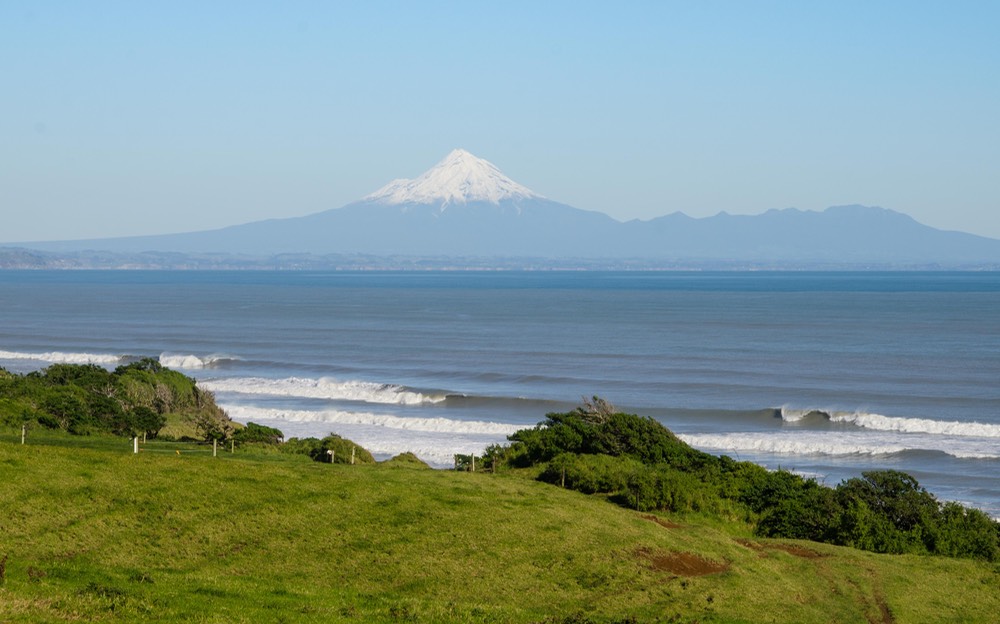
Mt Taranaki was beckoning, so we moved on. We had intended to drive around the base of the mountain, but realized the road ran inland from the coast and so it made more sense to head for Egmont Village and drive to the visitor center part way up the mountain. We knew we were possibly missing some interesting views of the mountain from various directions, but our plan sounded like the better choice (and at this point I still thought I had all the other cool pictures I’d taken). And we were not disappointed. It was a lovely day, but fading fast; we arrived at the visitor center to find them already closed and the sun rapidly heading for the horizon.
No problem; we knew we could stay the night in the parking lot and we’d be on the best side of the mountain (the east, silly) to watch the sun come up the next morning. Well cool — actually very cold! We were at 928 meters (3044 feet), there was snow on the ground in the parking lot, and a totally clear — and lovely — sky all night. Our night on Mt Taranaki was a mite chilly, down to 0˚C (32˚F) inside the van. But the sun came up, all was sparkly and clear, the mountain was beautiful and we were very pleased. It was great.
We spent time at the center, wandered the hillside a bit, enjoyed the rabbits playing beside the Scow, felt smug, and moved on. We were heading due east for a bit, to Stratford, where we were going to pick up the Forgotten World Highway. As we drove along, I was struck by how much this enormous mountain felt like part of the neighborhood. The fields and houses have this beautiful back drop, but life continues undisturbed; we who are visitors are continually struck by the loveliness of the mountain — we talk about it and take tons of pictures; the locals continue with chores and childrearing and grocery shopping and (probably) wishing there were fewer of us cluttering up the roads. Mt Taranaki/Egmont is a world class sight, often compared to Japan’s Mt Fuji; please don’t miss it if you visit New Zealand.
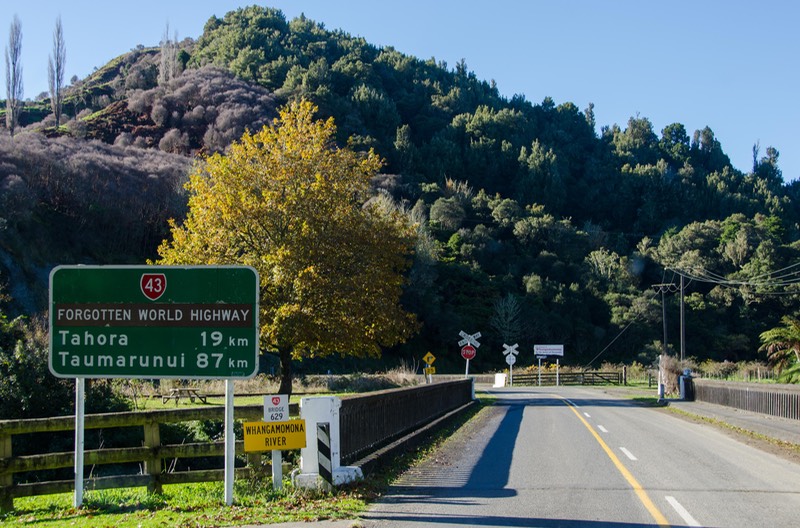
The Forgotten World Highway (SH43) runs between Stratford and Taumarunui. It’s billed as “genuinely rural New Zealand” and we couldn’t complain. It follows a lovely gorge through the mountains, contains a bunch of mud slides and is very wet in places; is narrow, messy and torn up, has lots of chunks missing out of the road, and is difficult to drive, though mostly paved. The non-paved part gave us a very flat, very torn-apart and ruined tire. So That Happened.
Marvel of marvels, we did have a spare. Rick proceeded to begin the process, people stopped to help, and we were able to complete our journey. We limped into Taumarunui, called the rental people, and they (after figuring out where in the hell Taumarunui might be), arranged for a replacement tire to meet us in Wanganui — tomorrow. One hundred miles away. But we got there, no further problems, and in Wanganui they took wonderful care of us.
We really like Wanganui, incidentally. It’s a great small city with a couple of excellent art galleries and museums; unfortunately they are both in temporary quarters as the city earthquake-proofs the permanent locations, but what we could see was excellent.
The people are incredibly friendly and helpful, and we had a good visit here. Early on, we stopped at the local Council offices, because we thought the I-Site was here (recently relocated, we found out). They were bright and cheerful and happy to talk to us, the lady found a map to show us where things were, and then took us upstairs to the Council chambers, where there is a very nice collection of stained glass windows depicting the history of the area. Lovely. We also had a great spot to stop for the night and picked up a couple of fantastic meat pies for dinner. Before leaving town in the morning we stopped in to pick up more.
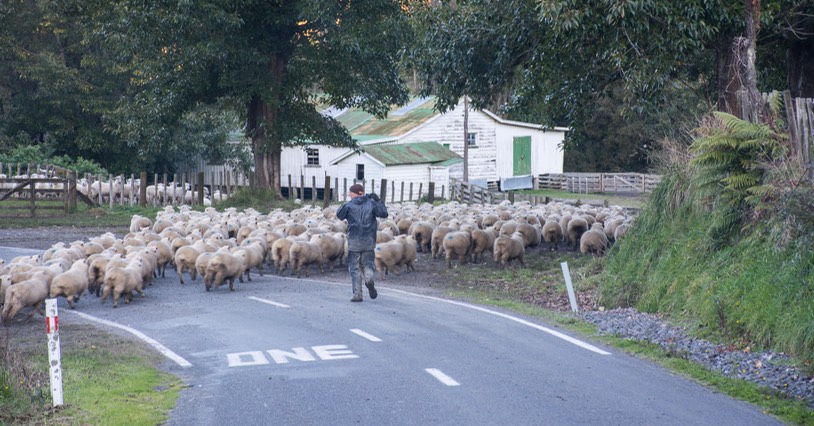
We are starting to see sheep being gathered, possibly for sale; less fall color visible; a little bit of the white stuff on the ground along the road; bee hives stacked for winter storage; all signs that winter is coming.
Continuing along our way, we came to the Otaki area, stopped for the night in a forest reserve north of town, then drove into town the next morning. We admired some great murals in the center of the village, but we were heading for the Rangiatea church. The original building was constructed in 1849 and was considered the finest Maori church in New Zealand. Shortly after completion of a full restoration project, it had been vandalized and burned down in the 90’s; this replica was completed in 2003. It’s lovely, if a bit too clean and pristine to look like a community church in regular use. But we were pleased to be able to see it and enjoy the carvings and woven panels.
Our next stop along the way was at the Southward Car Museum in Otaihanga, a bit north of Paraparaumu (aren’t these names great). This is generally referred to as New Zealand’s best car museum, and probably is. Begun by (later) Sir Len Southward, the museum houses a large collection of over 500 cars along with a few planes, motorcycles and other items in a large purpose-built facility opened in 1979.
Pride of place goes to a small group of racing cars that were mostly driven by New Zealand-born drivers and mostly raced in New Zealand. There are many notable cars in the collection, including a beautifully restored 1915 Stutz that placed 3rd in the Indy 500 of that year, and a lovely 1956 Maserati 250F, one of the most successful Grand Prix cars of the mid 50’s. The particular car on display was driven by Mike Hawthorn at the Argentine GP, owned and raced after that by Jack Brabham, and later raced by New Zealander Chris Amon. Overall, the collection is extensive and includes cars from 1895 to the 1990’s with a number of examples once owned by famous people, including actress Marlene Dietrich and gangster Mickey Cohen. A collection of photos from our visit to the museum will be posted to Motor-Museums.com as time allows.
And suddenly we were closing in on the bottom of the island and were about to arrive in Wellington. Were we ready? Are we ever? Well, sort of. No matter, on we would go and see what New Zealand’s capital had to offer us. We had to keep the bit between our teeth and keep moving, as we were leaving for Australia in two more weeks and still wanted to enjoy the whole eastern side of North Island. So Wellington! Watch out, here we come!
More soon, from Rick and Kathy and Scow II (bleep)
Click to see more photos from Kia Ora Aotearoa